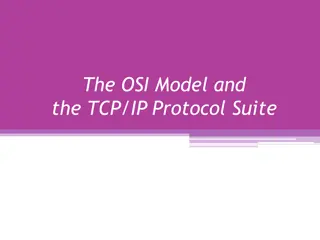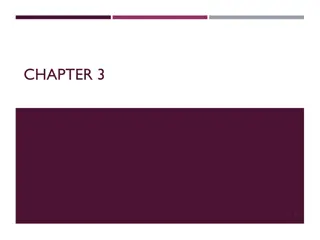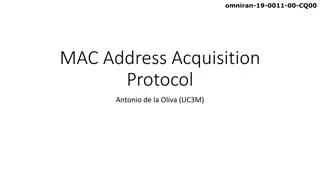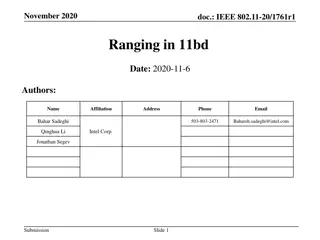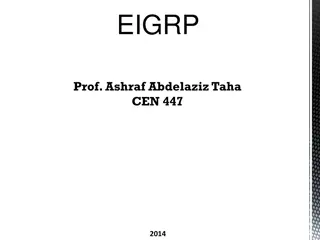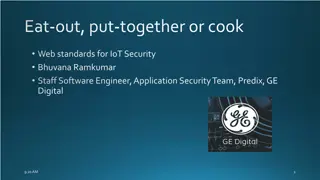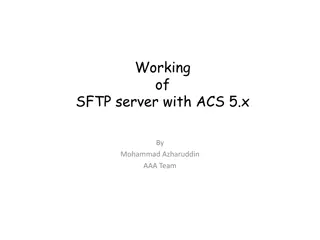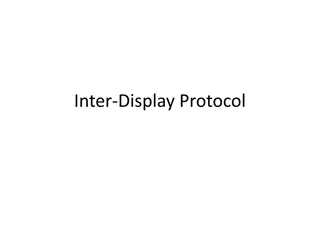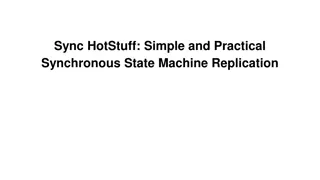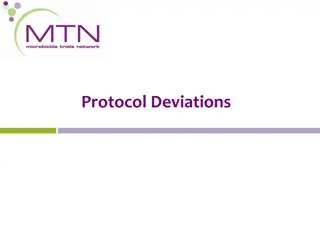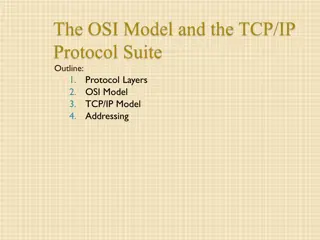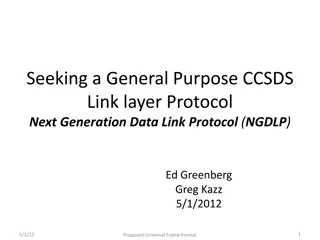An Overview of MQTT Protocol
MQTT, or MQ Telemetry Transport, is a lightweight publish/subscribe protocol ideal for remote sensors and control devices. It provides a messaging transport that is agnostic to payload content, supports various qualities of service for message delivery, and features Last Will and Testament for detecting improper client connections.
Download Presentation

Please find below an Image/Link to download the presentation.
The content on the website is provided AS IS for your information and personal use only. It may not be sold, licensed, or shared on other websites without obtaining consent from the author.If you encounter any issues during the download, it is possible that the publisher has removed the file from their server.
You are allowed to download the files provided on this website for personal or commercial use, subject to the condition that they are used lawfully. All files are the property of their respective owners.
The content on the website is provided AS IS for your information and personal use only. It may not be sold, licensed, or shared on other websites without obtaining consent from the author.
E N D
Presentation Transcript
What is MQTT ? MQTT = MQ Telemetry Transport MQTT protocol is a lightweight publish/subscribe protocol flowing over TCP/IP for remote sensors and control devices through low bandwidth, unreliable or intermittent communications. MQTT was developed by Andy Stanford-Clark of IBM, and Arlen Nipper of Cirrus Link Solutions more than a decade ago. ISO/IEC 20922:2016 Message Queuing Telemetry Transport (MQTT) v3.1.1. (Draft of v5.0 published in July, 2017) Client libraries are available in almost all popular languages now. https://eclipse.org/paho/ The current MQTT specification is available at: http://docs.oasis-open.org/mqtt/mqtt/v3.1.1/mqtt-v3.1.1.html http://docs.oasis-open.org/mqtt/mqtt/v5.0/mqtt-v5.0.html 2
Projects that Implement MQTT Amazon Web Services announced Amazon IoT based on MQTT in 2015 Microsoft Azure IoT Hub uses MQTT as its main protocol for telemetry messages Node-RED supports MQTT nodes as of version 0.14 Facebook has used aspects of MQTT in Facebook Messenger for online chat The EVRYTHNG IoT platform uses MQTT as an M2M protocol for millions of connected products.
Features of MQTT It supports publish/subscribe message pattern to provide one-to-many message distribution and decoupling of applications A messaging transport that is agnostic to the content of the payload Three qualities of service for message delivery: "At most once" , where messages are delivered according to the best efforts of the operating environment. Message loss can occur. This level could be used, for example, with ambient sensor data where it does not matter if an individual reading is lost as the next one will be published soon after. "At least once", where messages are assured to arrive but duplicates may occur. "Exactly once", where message are assured to arrive exactly once. This level could be used, for example, with billing systems where duplicate or lost messages could lead to incorrect charges being applied. A small transport overhead and protocol exchanges minimized to reduce network traffic. A mechanism to notify interested parties when an abnormal disconnection occurs. (Last Will and Testament)
Last Will and Testament The protocol provides a method for detecting when clients close their connections improperly by using keep-alive packets. So when a client crashes or it s network goes down, the broker can take action. Clients can send a Last Will and Testament (LWT) message to the broker at any point. When the broker detects the client has gone offline (without closing their connection), it will send out the saved LWT message on a specified topic, thus letting other clients know that a node has gone offline unexpectedly.
MQTT Pub/Sub Protocol MQ Telemetry Transport (MQTT) is a lightweight broker-based publish/subscribe messaging protocol. MQTT is designed to be open, simple, lightweight and easy to implement. These characteristics make MQTT ideal for use in constrained environments, for example in IoT. Where the network is expensive, has low bandwidth or is unreliable When run on an embedded device with limited processor or memory resources; A small transport overhead (the fixed-length header is just 2 bytes), and protocol exchanges minimized to reduce network traffic Source: MQTT V3.1 Protocol Specification, IBM, http://public.dhe.ibm.com/software/dw/webservices/ws-mqtt/mqtt-v3r1.html
Suitable for Constrained Networks Protocol compressed into bit-wise headers and variable length fields. Smallest possible packet size is 2 bytes Asynchronous bidirectional push delivery of messages to applications (no polling) Client to server and server to client Supports always-connected and sometimes-connected models Provides Session awareness Configurable keep alive providing granular session awareness Last will and testament enable applications to know when a client goes offline abnormally Typically utilzesTCP based networks e.g. Webscokets Tested on many networks
Publish Subscribe Messaging A Publish Subscribe messaging protocol allowing a message to be published once and multiple consumers (applications / devices) to receive the message providing decoupling between the producer and consumer(s) A producer sends (publishes) a message (publication) on a topic (subject) A consumer subscribes (makes a subscription) for messages on a topic (subject) A message server/broker matches publications to subscriptions If no matches the message is discarded If one or more matches the message is delivered to each matching subscriber/consumer
Broker/Publish/Subscribe https://zoetrope.io/tech-blog/brief-practical-introduction-mqtt-protocol-and-its-application-iot/
Publish Subscribe Messaging A topic forms the namespace Is hierarchical with each sub topic separated by a / <country>/<region>/<town>/<postcode>/<house>/alarmState A subscriber can subscribe to an absolute topic or can use wildcards: Single-level wildcards + can appear anywhere in the topic string sensors/+/uk/london/baker_street get data from all sensor types in London Multi-level wildcards # must appear at the end of the string sensors/temperature/uk/# Get temperature data from all locations in UK
Publish Subscribe Messaging A subscription can be durable or non durable Durable: Once a subscription is in place, a broker will forward matching messages to the subscriber: Immediately if the subscriber is connected If the subscriber is not connected, messages are stored on the server/broker until the next time the subscriber connects Non-durable: The subscription lifetime is the same as the time the subscriber is connected to the server / broker A publication may be retained A publisher can mark a publication as retained The broker / server remembers the last known good message of a retained topic The broker / server gives the last known good message to new subscribers i.e. the new subscriber does not have to wait for a publisher to publish a message in order to receive its first message
Publish/Subscribe https://www.slideshare.net/michaeljohnkoster/mqtt-rest-bridge
MQTT Message Format Structure of an MQTT Control Packet The message header for each MQTT command message contains a fixed header. Some messages also require a variable header and a payload. Fixed header, present in all MQTT Control Packets Variable header, present in some MQTT Control Packets Payload, present in some MQTT Control Packets
MQTT Message Format The format for fixed header: DUP: Duplicate delivery of a PUBLISH Control Packet QoS: Quality of Service RETAIN: RETAIN flag This flag is only used on PUBLISH messages. When a client sends a PUBLISH to a server, if the Retain flag is set (1), the server should hold on to the message after it has been delivered to the current subscribers. This allows new subscribers to instantly receive data with the retained, or Last Known Good, value.
Control Packet types CONNECT: Client request to connect to Server CONNACK: Connect acknowledgment PUBLISH: Publish message PUBACK: Publish acknowledgment PUBREC: Publish received (assured delivery part 1) PUBREL: Publish release (assured delivery part 2) PUBCOMP: Publish complete (assured delivery part 3)
Control Packet types SUBSCRIBE: Client subscribe request SUBACK: Subscribe acknowledgment UNSUBSCRIBE: Unsubscribe request UNSUBACK: Unsubscribe acknowledgment PINGREQ: PING request PINGRESP: PING response DISCONNECT: Client is disconnecting
QoS QoS Level 0: No acknowledgment from the client and the reliability will be the same as that of the underlying network layer, TCP/IP. QoS Level 1: This ensures that the message is delivered to the client at least once, but it could be delivered more than once. It relies on the client sending an ACK packet when it receives a packet. QoS Level 2: This ensures that a message is delivered once and only once. This method requires an exchange of four packets, and will decrease performance of the broker. This level is also often left out of MQTT implementations due to its relative complexity.
QoS https://zoetrope.io/tech-blog/brief-practical-introduction-mqtt-protocol-and-its-application-iot/
Variable Header CONNECT packet Client requests a connection to a Server Fixed header: packet type=1 Variable header: Protocol Name, Protocol Level (4), Connect Flags, Keep Alive Connect Flags Bit 7 6 5 4 3 2 1 0 User Name Flag Password Flag Will Retain Will QoS Will Flag Clean Session Reserved If the Will Flag is set to 1 this indicates that, if the Connect request is accepted, a Will Message MUST be stored on the Server and associated with the Network Connection. The Will Message MUST be published when the Network Connection is subsequently closed. Client crashes without sending a DISCONNECT Packet first
Payload CONNECT packet Client Identifier Will Topic Will Message User Name User Password
Security Authentication Username and password as part of CONNECT action Encryption SSL and plain text communication over TCP/IP Queue manager MQTT Client Broker Username/password Username/password Replied with Yes/No authentication module
Broker Software Mosquitto - One of the earliest production ready brokers, Mosquitto is written in C and offers high performance with a lot of configurability. Mosca - Written in Node.js, this can be embedded in a Node application or run as a standalone executable. Easy configuration and extensibility, also very performant. RSMB - IBM s implementation of the MQTT protocol. This is one of the less popular options but is a mature system, written in C. HiveMQ - HiveMQ is a relatively new player, and is oriented towards enterprise environments.



